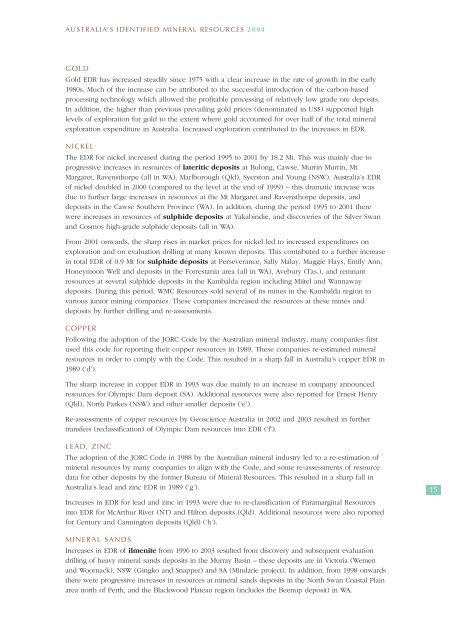australia's identified mineral resources 2004 - Geoscience Australia
australia's identified mineral resources 2004 - Geoscience Australia
australia's identified mineral resources 2004 - Geoscience Australia
You also want an ePaper? Increase the reach of your titles
YUMPU automatically turns print PDFs into web optimized ePapers that Google loves.
AUSTRALIA’S IDENTIFIED MINERAL RESOURCES <strong>2004</strong><br />
GOLD<br />
Gold EDR has increased steadily since 1975 with a clear increase in the rate of growth in the early<br />
1980s. Much of the increase can be attributed to the successful introduction of the carbon-based<br />
processing technology which allowed the profitable processing of relatively low grade ore deposits.<br />
In addition, the higher than previous prevailing gold prices (denominated in US$) supported high<br />
levels of exploration for gold to the extent where gold accounted for over half of the total <strong>mineral</strong><br />
exploration expenditure in <strong>Australia</strong>. Increased exploration contributed to the increases in EDR.<br />
NICKEL<br />
The EDR for nickel increased during the period 1995 to 2001 by 18.2 Mt. This was mainly due to<br />
progressive increases in <strong>resources</strong> of lateritic deposits at Bulong, Cawse, Murrin Murrin, Mt<br />
Margaret, Ravensthorpe (all in WA), Marlborough (Qld), Syerston and Young (NSW). <strong>Australia</strong>’s EDR<br />
of nickel doubled in 2000 (compared to the level at the end of 1999) – this dramatic increase was<br />
due to further large increases in <strong>resources</strong> at the Mt Margaret and Ravensthorpe deposits, and<br />
deposits in the Cawse Southern Province (WA). In addition, during the period 1995 to 2001 there<br />
were increases in <strong>resources</strong> of sulphide deposits at Yakabindie, and discoveries of the Silver Swan<br />
and Cosmos high-grade sulphide deposits (all in WA).<br />
From 2001 onwards, the sharp rises in market prices for nickel led to increased expenditures on<br />
exploration and on evaluation drilling at many known deposits. This contributed to a further increase<br />
in total EDR of 0.9 Mt for sulphide deposits at Perseverance, Sally Malay, Maggie Hays, Emily Ann,<br />
Honeymoon Well and deposits in the Forrestania area (all in WA), Avebury (Tas.), and remnant<br />
<strong>resources</strong> at several sulphide deposits in the Kambalda region including Miitel and Wannaway<br />
deposits. During this period, WMC Resources sold several of its mines in the Kambalda region to<br />
various junior mining companies. These companies increased the <strong>resources</strong> at these mines and<br />
deposits by further drilling and re-assessments.<br />
COPPER<br />
Following the adoption of the JORC Code by the <strong>Australia</strong>n <strong>mineral</strong> industry, many companies first<br />
used this code for reporting their copper <strong>resources</strong> in 1989. These companies re-estimated <strong>mineral</strong><br />
<strong>resources</strong> in order to comply with the Code. This resulted in a sharp fall in <strong>Australia</strong>’s copper EDR in<br />
1989 (‘d’).<br />
The sharp increase in copper EDR in 1993 was due mainly to an increase in company announced<br />
<strong>resources</strong> for Olympic Dam deposit (SA). Additional <strong>resources</strong> were also reported for Ernest Henry<br />
(Qld), North Parkes (NSW) and other smaller deposits (‘e’).<br />
Re-assessments of copper <strong>resources</strong> by <strong>Geoscience</strong> <strong>Australia</strong> in 2002 and 2003 resulted in further<br />
transfers (reclassification) of Olympic Dam <strong>resources</strong> into EDR (‘f’).<br />
LEAD, ZINC<br />
The adoption of the JORC Code in 1988 by the <strong>Australia</strong>n <strong>mineral</strong> industry led to a re-estimation of<br />
<strong>mineral</strong> <strong>resources</strong> by many companies to align with the Code, and some re-assessments of resource<br />
data for other deposits by the former Bureau of Mineral Resources. This resulted in a sharp fall in<br />
<strong>Australia</strong>’s lead and zinc EDR in 1989 (‘g’).<br />
Increases in EDR for lead and zinc in 1993 were due to re-classification of Paramarginal Resources<br />
into EDR for McArthur River (NT) and Hilton deposits (Qld). Additional <strong>resources</strong> were also reported<br />
for Century and Cannington deposits (Qld) (‘h’).<br />
15<br />
MINERAL SANDS<br />
Increases in EDR of ilmenite from 1996 to 2003 resulted from discovery and subsequent evaluation<br />
drilling of heavy <strong>mineral</strong> sands deposits in the Murray Basin – these deposits are in Victoria (Wemen<br />
and Woornack), NSW (Gingko and Snapper) and SA (Mindarie project). In addition, from 1998 onwards<br />
there were progressive increases in <strong>resources</strong> at <strong>mineral</strong> sands deposits in the North Swan Coastal Plain<br />
area north of Perth, and the Blackwood Plateau region (includes the Beenup deposit) in WA.

















